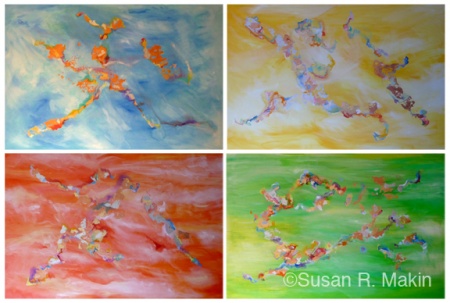
Plane travel is a privilege. Seat belt buckled, I start to relax and enjoy a break from pressures of life on the ground. Spending time in winter-weather Canada, dreams of warmer destinations sustain and sooth. Favorite views are of island formations, miles of beaches, desserts, jungles, lush plains, tropical waters—sun-kissed vistas. My imagination is infinite. It urges to turn up the volume, generate warmth, hope, possibility. This Tropical Topography series as example.
I painted all works in layers and at intervals, choosing a different main color for each separate canvas. All applications of metal leaf were intentional. Every brush stroke counted. Diverse elements came together with a glint of magic. Sun kissed!
Always a colorist, but even more so after a trip to India. Cobalt blue, ruby red, amber yellow, emerald green, all pushed to have place and space, and I let them. Then came gold, silver, and bronze. Each needed to be there, separately and together.
For Topographies 1 and 2, I applied the gold and silver leaf first, then added color bases around them: one color per canvas (red, yellow, blue, green) for each size grouping,. Topographies 3 - 6, phase two of this collection, came in response to the successful completion of phase one, and my evolved. For this, I primed all canvases first, each with a different color base (red, yellow, blue, green). Of prime importance in the beginning here were the colors themselves: being able to see what worked with each.
For every Topography canvas came the build up, layer by layer. Shades, highlights, and contrasts emerged. As specific tones developed or stood out, I went with whatever pushed to appear and gave it room. Forms gradually developed. Then came the challenge: to honor and preserve the message and magic of spontaneous brush strokes Not to overwork was imperative: to set them off to advantage without tainting essence.
Size matters, as does color. With these pieces, I challenge myself and gain insight. I discover what works more easily and what might not work at all. I push, adjust, experiment. “Similar, but different” is a recurring theme: the name of a 2008 Triptych of mine. Different base colors and dimensions influence what works and doesn’t. All canvases experience similar attention to detail, but some appear more appealing than others. Images are set up to fail and/or succeed from the start, even if not realized initially. Interesting to notice which pieces in a particular color and dimension might not work well alone, but have more impact in combination.
Tropical Topographies 3
(4 x (60 x 40 in), oil, oil stick, and metallic leaf on canvas, 2011)
We live in a beautiful but fragile world. Something not to be taken fore granted. Formations that look idyllic from above, may not be from ground level. When I started painting this series Japan’s March 2011 earthquake and tsunami hadn’t yet happened. In their aftermath, how I approached these images—and completed them—changed. I couldn’t help but think about the turmoil Mother Nature brings: the taking away of innocence, the once calm and peaceful turned upside down. Ironically, even something that’s unpleasant like rubble and debris, if looked at with an artistic eye, may present interesting formations. Tropical Topographies 3 is larger than others included in the series. It lays out island formations comprehensively: their coming together and falling off. Some shine in the moment then are gone. Others live on indefinitely, no change. We are not in control of everything. Some see what they want to. Others see what they have to: soothing, upsetting, or unremarkable. Each of the four canvases created here (red, yellow, blue, and green) can be viewed vertically or horizontally and all catch the light at different angles. Bronze, sliver, and gold leaf-like materials glimmer and shimmer according to lighting and vantage point. What’s noticed by one viewer might not be by another. The magic of putting brush to canvas cannot be underrated, especially when the painter working with them has a spontaneous bent—goes with the moment and adapts to whatever feels right.
